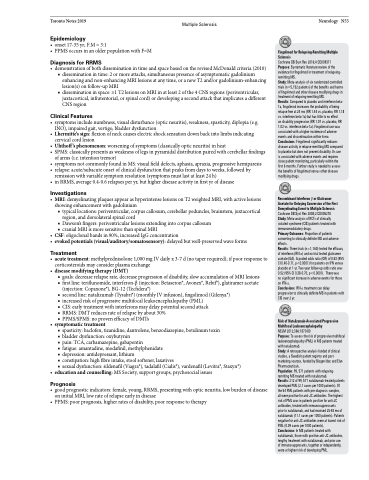Page 795 - TNFlipTest
P. 795
Toronto Notes 2019
Multiple Sclerosis
Neurology N53
Epidemiology
• onset17-35yr;F:M=3:1
• PPMSoccursinanolderpopulationwithF=M
Diagnosis for RRMS
• demonstrationofbothdisseminationintimeandspacebasedontherevisedMcDonaldcriteria(2010) ■ dissemination in time: 2 or more attacks, simultaneous presence of asymptomatic gadolinium
enhancing and non-enhancing MRI lesions at any time, or a new T2 and/or gadolinium-enhancing
lesion(s) on follow-up MRI
■ dissemination in space: ≥1 T2 lesions on MRI in at least 2 of the 4 CNS regions (periventricular,
juxtacortical, infratentorial, or spinal cord) or developing a second attack that implicates a different CNS region
Clinical Features
• symptomsincludenumbness,visualdisturbance(opticneuritis),weakness,spasticity,diplopia(e.g. INO), impaired gait, vertigo, bladder dysfunction
• Lhermitte’ssign:flexionofneckcauseselectricshocksensationdownbackintolimbsindicating cervical cord lesion
• Uhthoff ’s phenomenon: worsening of symptoms (classically optic neuritis) in heat
• SPMS:classicallypresentsasweaknessoflegsinpyramidaldistributionpairedwithcerebellarfindings
of arms (i.e. intention tremor)
• symptomsnotcommonlyfoundinMS:visualfielddefects,aphasia,apraxia,progressivehemiparesis
• relapse:acute/subacuteonsetofclinicaldysfunctionthatpeaksfromdaystoweeks,followedby
remission with variable symptom resolution (symptoms must last at least 24 h)
• inRRMS,average0.4-0.6relapsesperyr,buthigherdiseaseactivityinfirstyrofdisease
Investigations
• MRI:demyelinatingplaquesappearashyperintenselesionsonT2weightedMRI,withactivelesions showing enhancement with gadolinium
■ typical locations: periventricular, corpus callosum, cerebellar peduncles, brainstem, juxtacortical region, and dorsolateral spinal cord
■ Dawson’s fingers: periventricular lesions extending into corpus callosum
■ cranial MRI is more sensitive than spinal MRI
• CSF:oligoclonalbandsin90%,increasedIgGconcentration
• evokedpotentials(visual/auditory/somatosensory):delayedbutwell-preservedwaveforms
Treatment
• acutetreatment:methylprednisolone1,000mgIVdailyx3-7d(notaperrequired);ifpoorresponseto corticosteroids may consider plasma exchange
• diseasemodifyingtherapy(DMT)
■ goals: decrease relapse rate, decrease progression of disability, slow accumulation of MRI lesions
■ first line: teriflunomide, interferon-β (injection: Betaseron®, Avonex®, Rebif®), glatiramer acetate
(injection: Copaxone®), BG-12 (Tecfidera®)
■ second line: natalizumab (Tysabri®) (monthly IV infusion), fingolimod (Gilenya®)
■ increased risk of progressive multifocal leukoencephalopathy (PML)
■ CIS: early treatment with interferons may delay potential second attack
■ RRMS: DMT reduces rate of relapse by about 30% ■ PPMS/SPMS: no proven efficacy of DMTs
• symptomatictreatment
■ spasticity: baclofen, tizanidine, dantrolene, benzodiazepine, botulinum toxin ■ bladder dysfunction: oxybutynin
■ pain: TCA, carbamazepine, gabapentin
■ fatigue: amantadine, modafinil, methylphenidate
■ depression: antidepressant, lithium
■ constipation: high fibre intake, stool softener, laxatives
■ sexual dysfunction: sildenafil (Viagra®), tadalafil (Cialis®), vardenafil (Levitra®, Staxyn®)
• educationandcounselling:MSSociety,supportgroups,psychosocialissues
Prognosis
• goodprognosticindicators:female,young,RRMS,presentingwithopticneuritis,lowburdenofdisease on initial MRI, low rate of relapse early in disease
• PPMS:poorprognosis,higherratesofdisability,poorresponsetotherapy
Fingolimod for Relapsing-Remitting Multiple Sclerosis
Cochrane DB Syst Rev 2016;4:CD009371 Purpose: Systematic literature review of the evidence for fingolimod in treatment of relapsing- remitting MS.
Study: Meta-analysis of six randomized controlled trials (n=5,152 patients) of the benefits and harms of fingolimod and other disease modifying drugs in treatment of relapsing-remitting MS.
Results: Compared to placebo and interferon beta- 1a, fingolimod increases the probability of being relapse free at 24 mo (RR 1.44 vs. placebo, RR 1.18 vs. interferon beta-1a) but has little to no effect
on disability progression (RR 1.07 vs. placebo, RR 1.02 vs. interferon beta-1a). Fingolimod use was associated with a higher incidence of adverse events and discontinuation within 6 mo. Conclusions: Fingolimod significantly reduces disease activity in relapse-remitting MS compared to placebo but does not prevent disability. Its use is associated with adverse events and requires close patient monitoring, particularly within the first 6 months. Further study is needed to assess the benefits of fingolimod versus other disease modifying drugs.
Recombinant Interferon β or Glatiramer
Acetate for Delaying Conversion of the First Demyelinating Event to Multiple Sclerosis Cochrane DB Syst Rev 2008;2:CD005278
Study: Meta-analysis of RCTs of clinically
isolated syndrome (CIS) patients treated with immunomodulatory drugs.
Primary Outcomes: Proportion of patients converting to clinically definite MS and adverse effects.
Results: Three trials (n=1,160) tested the efficacy of interferon (IFN-α) and no trial tested glatiramer acetate (GA). A pooled odds ratio (OR) of 0.53 (95% CI 0.40-0.71, p<0.0001) for patients on IFN versus placebo at 1 yr. Two year follow-up odds ratio was 0.52(95%CI0.38-0.70,p<0.0001). Therewas
no significant increase in adverse events for those on IFN-α.
Conclusions: IFN-α treatment can delay progression to clinically definite MS in patients with CIS over 2 yr.
Risk of Natalizumab-Associated Progressive Multifocal Leukoencephalopathy
NEJM 2012;366:1870-80
Purpose: To assess the risk of progressive multifocal leukoencephalopathy (PML) in MS patients treated with natalizumab.
Study: A retrospective analysis funded of clinical studies, a Swedish patient registry and post- marketing sources, funded by Biogen Idec and Elan Pharmaceuticals.
Population: 99, 571 patients with relapsing- remitting MS treated with natalizumab.
Results: 212 of 99, 571 natalizumab-treated patients developed PML (2.1 cases per 1000 patients). Of the 54 PML patients with pre-diagnosis samples,
all were positive for anti-JC antibodies. The highest risk of PML was in patients positive for anti-JC antibodies, treated with immunosuppressants
prior to natalizumab, and had received 25-48 mo of natalizumab (11.1 cases per 1000 patients). Patients negative for anti-JC antibodies were at lowest risk of PML (0.09 cases per 1000 patients).
Conclusions: In MS patients treated with natalizumab, those with positive anti-JC antibodies, lengthy treatment with natalizumab, and prior use of immunosuppresants, together or independently, were at highest risk of developing PML.


